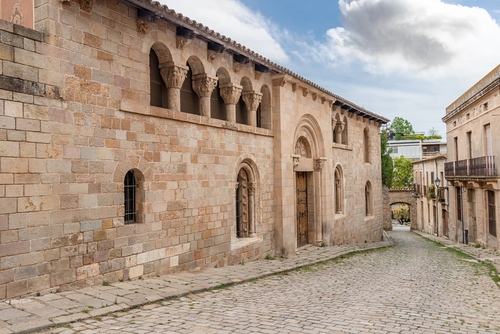
Nestled in the heart of Pedralbes, Barcelona's most affluent district, lies the Royal Monastery of St Mary of Pedralbes. This magnificent architectural complex, rooted in history, is a testament to the grandeur of Catalan Gothic design and the region's rich cultural tapestry.
Founded in 1326 by Queen Elisenda de Montcada and her husband King James II, the Monastery of Pedralbes was conceived as a sanctuary for the Order of Saint Clare, or the Poor Clares, where nuns could dedicate their lives to prayer and contemplation. After the king’s death, Queen Elisenda moved to the palace situated next to the monastery. From there, she was able to continue exercising her power and influence.
The Monastery’s architectural beauty is a sublime fusion of Catalan Gothic with Mudejar styles, the latter being a style derived from the Islamic. With its soaring pointed arches and rib-vaulted ceilings, the church is a masterpiece of the period. The elegant cloisters, with their slender columns and detailed capitals, provide a tranquil space for reflection and are a testament to the skilled craftsmen of the time.
Within the church, the marble sarcophagus of Queen Elisenda de Montcada, sculpted during her lifetime, is a masterpiece of Gothic sculpture. It is a double-sided tomb, with one side facing the cloister and depicting Elisenda as a penitent widow, while the one inside the church represents her as a queen, wearing royal garments and a crown. Her tomb is a magnificent work of art and a symbol of the reverence bestowed upon her by her contemporaries.

The Monastery’s three-storey cloister is considered the largest Gothic cloister in the world, with twenty-one columns on each side supporting the sublime Gothic pointed arches. With its lush gardens, the cloister is a tranquil retreat where time seems to stand still.
One distinctive feature of the monastery, which was declared a national monument in 1991, is that it still serves as a home for a small community of nuns. In line with Queen Elisenda's vision, they live in seclusion, maintaining the monastery and its legacy.
St Mary of Pedralbes is now a museum of monastic life, that allows visitors to explore its history and view a collection of religious art, manuscripts, and historical artefacts. It offers a glimpse into the past and an opportunity to admire its architectural splendour and sense of history, through different spaces like St Michael’s Chapel, the dormitory, refectory, kitchen, infirmary, storerooms, abbey room and chapter house, plus various day cells.
The Monastery of Pedralbes is a priceless jewel of Barcelona. It is a testament to monastic life, the grandeur of the Gothic style and the enduring legacy of Queen Elisenda's vision. It is a place where the past and the present coexist, allowing visitors to appreciate the artistry and spirituality of a bygone era. This exquisite sanctuary of history, art, and tradition is a must-visit for anyone exploring the rich cultural heritage of Barcelona.

